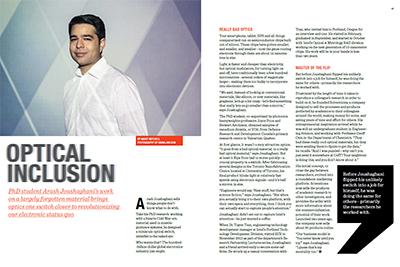PhD student Arash Joushaghani’s work on a largely forgotten material brings optics one switch closer to revolutionizing our electronic status quo
By Marit Mitchell

Arash Joushaghani sells things people don’t know what to do with.
Take his PhD research: working with a bizarre Cold War-era material used in missile-guidance systems, he designed a miniscule optical switch, invisible to the naked eye.
Who wants that? The hundred-billion-dollar global electronics industry just might.
Really Bad Optics
Your smartphone, tablet, GPS and all things computerized run on semiconductor chips built out of silicon. These chips have gotten smaller, and smaller, and smaller—now the gates routing electrons through them are about 14 nanometres in size.
Light is faster and cheaper than electricity, but optical modulators, for turning light on and off, have traditionally been a few hundred micrometres—several orders of magnitude larger—making them too bulky to incorporate into electronic devices.
“We said, instead of looking at conventional materials, like silicon, or new materials, like graphene, let’s go a bit crazy—let’s find something that really lets us go smaller than a micron,” says Joushaghani.
The PhD student, co-supervised by photonics heavyweights Professors Joyce Poon and Stewart Aitchison, obtained samples of vanadium dioxide, or VO2, from Defence Research and Development Canada’s primary research centre in Valcartier, Quebec.
At first glance, it wasn’t a very attractive option. “It goes from a bad optical material, to a really bad optical material,” says Joushaghani. But at least it flips from bad to worse quickly—a crucial property in a switch. After fabricating several designs in the Toronto Nanofabrication Centre located at University of Toronto, his final product blinks light at relatively fast speeds using electronic signals—and it’s half a micron in size.
“Engineers would say, ‘Neat stuff, but that’s science fiction,’” says Joushaghani. “But when you actually bring it to their own platform, with their own specs and everything, then I think you can actually start to capture people’s attention.”
Joushaghani didn’t set out to capture Intel’s attention—he just wanted a coffee.
When Dr. Tuyen Tran, engineering technology development manager at Intel’s Portland Technology Development Division, visited ECE in November 2013 as part of the department’s Research Partnership Lectures series, Joushaghani and a friend arrived early to secure some caffeine. He struck up a casual conversation with Tran, who invited him to Portland, Oregon for an interview and tour. He visited in February, graduated in September, and started in October with Intel’s Optical & Metrology R&D division working on the next generation of 10-nanometre chips. His work will be in your hands in less than two years.
Master of the Flip
But before Joushaghani flipped his unlikely switch into a job for himself, he was doing the same for others—primarily the researchers he worked with.
Frustrated by the length of time it takes to reproduce a colleague’s research in order to build on it, he founded Sciventions, a company designed to sell the processes and products perfected by academics to their colleagues around the world, making money for some, and saving years of time and effort for others. His entrepreneurial inspiration arrived while he was still an undergraduate student in Engineering Science, and working with Professor Geoff Ozin in the Department of Chemistry. “They had these really cool optical materials, but they were sending them to Spain to get the data,” he recalls. “And I was puzzled—why can’t you just send it somewhere at UofT? Your neighbour is doing this, and you don’t know about it.”
His initial concept, to close the gap between researchers, evolved into a roundabout marketing platform: Sciventions now sells the products of academic research to other investigators, and provides the seller with more information about the commercialization potential of their work. Launched two years ago, the company now sells about 30 products online.
“Our business model is ‘You never know until you try,’” says Joushaghani. “I guess that’s my mentality too.”
 This feature appeared in the latest issue of ANNUM: read or download the full magazine.
This feature appeared in the latest issue of ANNUM: read or download the full magazine.